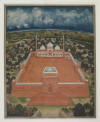|
saLT |
the-south-asian Life & Times Oct - Dec 2010 |
|
|||
|
Cover Feature Photo
Feature Aviation Comment
|
|
||||
|
Delhi Under the Mughals – 1526 -
1858 The Mughal period in the history of India is known for its aesthetic excellence in art and architecture and it was also during the three hundred and thirty years reign of the Mughals that Delhi saw its best and also its worst. These central Asian warriors, descendents of Timur and Ghenghiz Khan, married Hindu Rajput princesses who bore them sons and by the time of Shah Jahan, their ethnic stock was more Rajput than Mongol. Three of Shah Jahan’s four grandparents were Hindu Rajputs. The Mughals swung back and forth between Delhi and Agra as their capital cities – but Delhi remained the eye of their geographical radar. From the time Shah Jahan built Shahjahanabad - his custom-built city in Delhi – the Mughal rulers did not move elsewhere. The Red Fort, the Jama Masjid, Chandni Chowk, Kashmiri Gate – and countless other mansions, mosques, gardens, neighbourhoods, and tombs were built during their time. Each of the Mughal rulers left his distinct stamp – and like all other humans, they had their fads and foibles, their weaknesses and strengths, their own belief system. This article will introduce our readers to them all. Babar – founder of the Mughal dynasty in India Ruled 4 years 1526 – 1530 It was in April 1526 that Babar defeated and
conquered Ibrahim Lodhi at the Battle of Panipat, near Delhi. He sent his
18-year-old son Humayun to Agra to secure the treasure, marched to Delhi and
proclaimed himself the Padshah of Hindustan, and became the founder of the
Mughal dynasty in India. Born – 14 February 1483 in Andijan, Central Asia Died – 26 December 1530, of fever, aged 47, in Agra, India. Buried 9 years later, as per his wishes, in a garden in Kabul. His sister Khanzada and son Hindal also buried on the same garden terrace in Kabul. Accession to power – 11 years old when he inherited Ferghana. Ethnic Stock – Turko Mongol prince from Ferghana, a small kingdom east of Samarkand. Descended from Timur on father’s side and from Genghis Khan on his mother’s. Father – Umar Shaikh, ruler of Ferghana. Died in 1497 when Babar was 11 years old. Mother tongue – Chaghatai Turkish. Siblings (known) – sister Khanzada, half-brother Jahangir Children – Four sons : Humayun b 1508; Kamran b 1509; Askari b 1516; and Hindal b 1519; daughter Gulbadan Strengths – a great soldier and a prolific writer Passions – gardening and writing. Created many gardens - his favourite on a hillside in Kabul where his body was brought back to be buried. Composed verses in Persian. Wrote his memoirs – Babar namah – in his mother tongue. Grandson Akbar had them translated into Persian and illustrated. These manuscripts were probably lost in the looting of Delhi by Nadir Shah in 1739. A naturalist too and a book lover – set up a family library. Arrival in India – April 1526. Defeated Ibrahim Lodhi at the Battle of Panipat, marched towards Delhi and declared himself Padshah of India. Victory due to – superior cavalry tactics and moveable artillery. Babar’s troops numbered only 12,000 compared to Ibrahim Lodhi’s 100,000 – but Babar’s strongest assets were his two Persian gunners who were skilled in the art of cannons – a piece of artillery unknown in the Indian sub-continent at the time. The noise of the cannons terrified Ibrahim’s elephants – and the rest, as they say, is history! Military Campaigns – defeated Rajput Confederacy led by Rana Sanga – in 1527. Defeated joint forces of Afghans and Sultan of Bengal in 1529. Character traits – modest, simple, religious. tolerant towards non-Muslims As a ruler – liberal and tolerant towards the majority non-Muslim subjects. He believed that " defeated enemies must be conciliated, not antagonised if they are to be ruled effectively" and that "one’s own followers must be prevented by discipline from victimising local population." Weaknesses – Not an administrator. Was a hard drinker but said to have given up wine 2 days before the battle with the Rajputs, to obtain God’s favours. Inherited – small kingdom of Ferghana Extent of Kingdom at death – Consolidated and enlarged his conquered territory. His Empire in 1530 included Afghanistan, Kashmir, Punjab, Bihar and Malwa. Capital city - Agra Humayun - the second Mughal Founded the first school of Mughal painting Died age 48 Ruled - 2 terms as Emperor - 1530 –1540 and then July 1555 – January 1556 Akbar - The Third Mughal A great statesman and a brilliant administrator Died age 63 Ascended throne at age 13 Ruled almost 50 years 1556 – 1605 Jahangir – the Fourth Mughal Ruled 22 years 1605 - 1627 Shah Jahan – the Fifth Mughal Died at age 74
Aurangzeb - The Sixth Mughal Ruled almost 50 years 1658 - 1707
The Last Mughals in Delhi 1707 - 1858 Emperor Shah Alam Akbar II The last of the Mughal emperors, Bahadur Shah Zafar ascended the throne when he was little over 60. A poet, a brilliant calligrapher, a mystic, and author of four divans, he created an unparalleled court culture. Arrested after the 1857 uprising, Bahadur Shah Zafar was sent off to Rangoon in exile on bullock cart. The princes, his children were all shot in cold blood. Four years later, the last emperor died in exile in Rangoon on Friday November 7 1862, aged 87. With it – came the end of the Mughal dynasty. Read the entire feature in the print edition of
|
|||||
|
Copyright © 2000 - 2010 [the-south-asian.com]. Intellectual Property. All rights reserved. |
|||||
